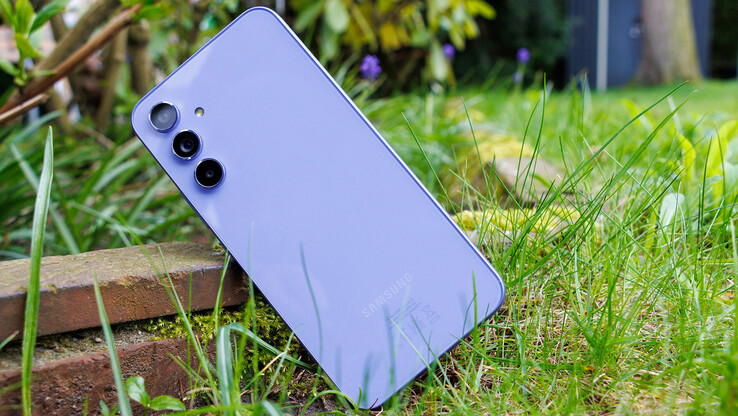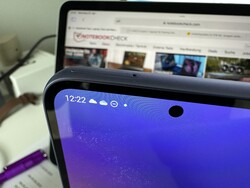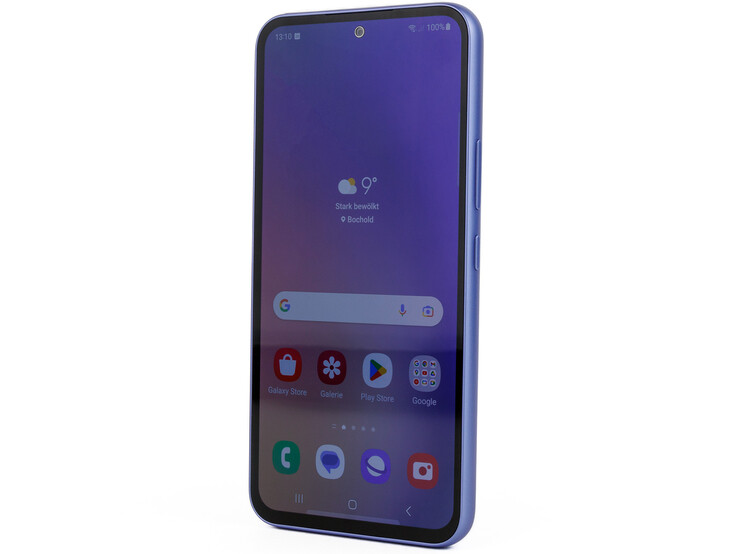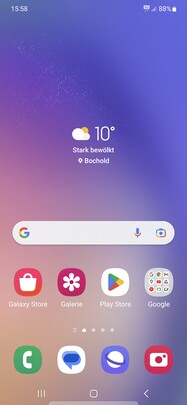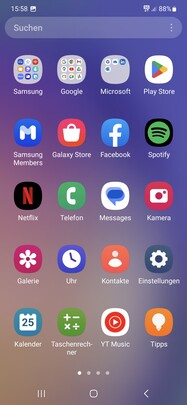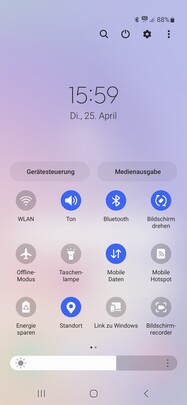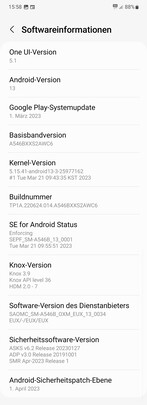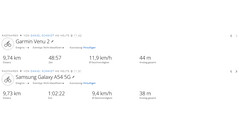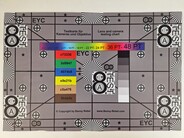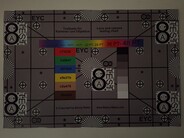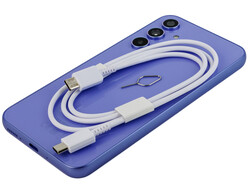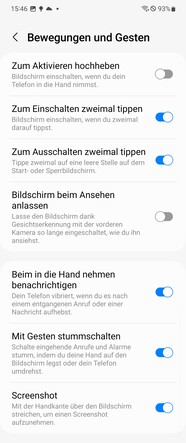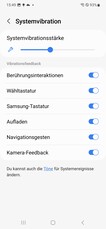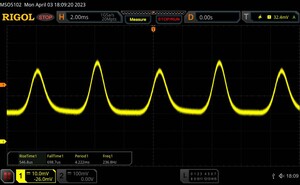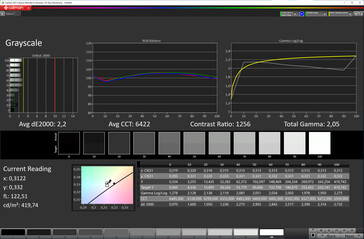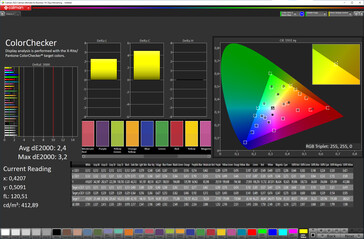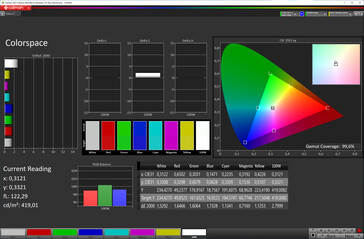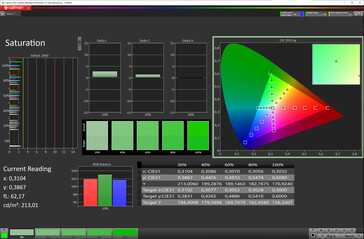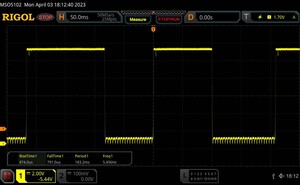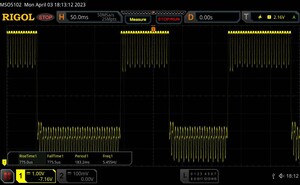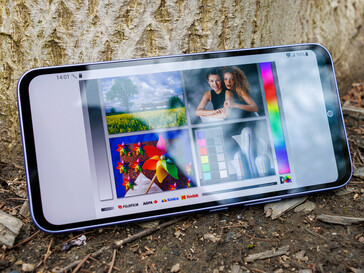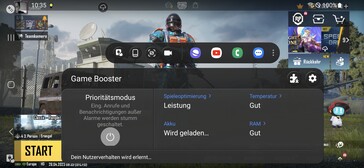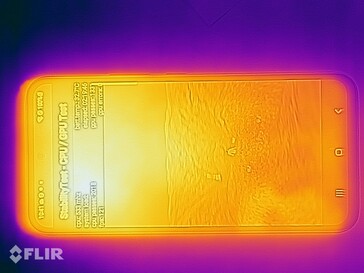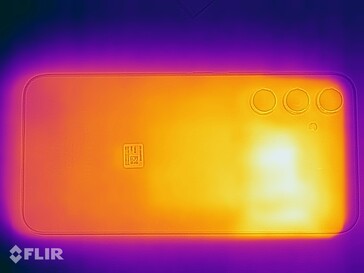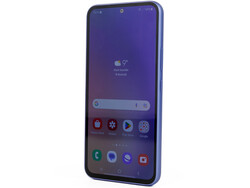Samsung Galaxy A54 5G review - A powerful, mid-range smartphone with many upgrades
The Galaxy A54 5G spearheads Samsung's mid-range 2023 models and is the direct successor to the Galaxy A53 5G. Unlike the high-end series, the manufacturer remains committed to its own processors and has opted for the new Exynos 1380, now with more RAM at its disposal. A lot has also happened with the camera: The depth camera is gone, and the A54 has received a 50 MP sensor instead of the 64 MP one which should result in significantly better images under poor lighting conditions.
The storage configurations are almost identical; the only difference is that the 128 GB and 256 GB models have 8 GB of RAM at their disposal. Unfortunately, everything is more expensive. The small variant now costs $449 (RRP, + $30) and the larger version, $499 (+ $20).
Possible competitors compared
Rating | Date | Model | Weight | Drive | Size | Resolution | Price |
|---|---|---|---|---|---|---|---|
| 86 % v7 (old) | 05 / 2023 | Samsung Galaxy A54 5G Exynos 1380, Mali-G68 MP5 | 202 g | 128 GB UFS 2.2 Flash | 6.40" | 2340x1080 | |
| 86.4 % v7 (old) | 04 / 2023 | Xiaomi 13 Lite SD 7 Gen 1, Adreno 644 | 171 g | 256 GB UFS 2.2 Flash | 6.55" | 2400x1080 | |
| 86.1 % v7 (old) | 04 / 2022 | Apple iPhone SE 2022 A15, A15 GPU 5-Core | 144 g | 64 GB SSD | 4.70" | 1334x750 | |
| 85.8 % v7 (old) | 09 / 2022 | Google Pixel 6a Tensor, Mali-G78 MP20 | 178 g | 128 GB UFS 3.1 Flash | 6.10" | 2400x1080 | |
| 82.9 % v7 (old) | 09 / 2022 | Sony Xperia 10 IV SD 695 5G, Adreno 619 | 161 g | 128 GB UFS 2.1 Flash | 6.00" | 2520x1080 |
Case - The A54 speaks the same design language as the Galaxy S23
Visually, the Samsung Galaxy A54 5G is reminiscent of the Galaxy S23+ but, at 83 percent, it has a worse display-to-body ratio. The Samsung smartphone comes in the colors Awesome Lime, Black, Violet and White with our review model being the violet version.
The Galaxy A54 has an accent colour aluminium frame and is protected by Corning Gorilla Glass 5 on both the front and rear of the device. The camera's three lenses protrude by 2.1 millimeters and cause the smartphone to wobble quite considerably on a flat surface. However, this can be compensated for by using an optional protective case.
Attempts to twist the Galaxy A54 5G are met with resistance, and only slight creaking can be heard. Thanks to AMOLED technology, the display is not overly sensitive to pressure and, as such, no waves can be seen when pressing firmly on the panel. We were impressed with the build quality which is characterized by a tight, smooth fit and finish. Only the card slot's covers are not completely flush and stick out a little on the left side of our review model. Otherwise, the A54 makes a very premium impression.
The Samsung smartphone's battery is fitted securely inside the device making it impossible to be swapped by the user. The intrusion of dust and water is prevented thanks to IP67 certification. But, in terms of sustainability, Samsung has to be held responsible, because the smartphone not only comes with a plastic film covering the frame but is also wrapped in a clear plastic film. This would surely have also been possible by using fewer resources.
Features - The Galaxy A54 5G has a speedy microSD slot
The Samsung Galaxy A54 5G might not have a 3.5 mm headphone jack as this job is managed by the USB-C port, providing a suitable adapter is used. Of course, USB headphones do not require this. Data transfer takes place via USB 2.0, however, wired video output through this port is not possible. Likewise, OTG is also supported meaning peripheral devices and external storage media can be connected. In testing, we tried this with an external SSD but the A54 unfortunately informed us that an external power source was necessary. The smartphone itself cannot provide enough power. However, a USB stick was not a problem.
Bluetooth has been upgraded to the latest 5.3 version and an NFC chip is also on board.
MicroSD card reader
In this price category, a microSD card slot is actually no longer obligatory which means the A54 is all the better for having one. Additionally, we are dealing with a comparatively fast one which impressed us not only with its consistently high data speeds but also due to possessing the exFAT file system.
A minor downside is that this is a hybrid slot. This means the user could have to decide between a memory card and a physical SIM card.
| SD Card Reader - average JPG Copy Test (av. of 3 runs) | |
| Samsung Galaxy A54 5G (Angelbird AV Pro V60) | |
| Sony Xperia 10 IV (Angelbird AV Pro V60) | |
| Samsung Galaxy A53 (Angelbird V60) | |
Cross Platform Disk Test (CPDT)
Software - The Galaxy A54 5G will even get Android 17
The Samsung Galaxy A54 5G comes with Google Android 13 as well as its in-house UI, One 5.1. Just like the expensive, high-end smartphones, the device will receive four major Android updates and five years of security patches (as of the smartphone"s launch date). At the time of testing, these were up-to-date, as of April 1st, 2023. In the first four years, monthly patches will be distributed with this changing to quarterly in the final year.
In addition to Google's apps, various Samsung apps are also preinstalled, including Galaxy Store. Third-party offerings such as Spotify, Netflix, Meta and Microsoft are also available but not all of them can be completely uninstalled, some can only be deactivated.
Communication and GNSS - Now with Wi-Fi 6
When it comes to mobile connectivity, the Galaxy A54 is almost entirely unchanged compared to its predecessor. Only a 5G frequency band has been added and, with good coverage, there shouldn't be any problems connecting to the network in many non-European countries.
In terms of Wi-Fi, there is one major update as the Samsung smartphone now also finally supports Wi-Fi 6 with VHT80. This ensures high data transfer rates, although when sending data we measured a temporary drop in data transfer speed in conjunction with our reference router, the Asus ROG Rapture GT-AXE11000. However, in practice, this shouldn't be noticeable. The Xiaomi 13 Lite is even faster, twice as fast, in actual fact, due to VHT160, but is similarly unable to make use of the 6 GHz network.
Even indoors, the Samsung Galaxy A54 5G manages a quick and accurate satellite fix. Outdoors, this also takes place with exemplary precision. The Samsung smartphone supports most common satellite systems, albeit mostly only one band.
On a short bike tour, we compared the A54 to the Garmin Venu 2. On the entire trip, measuring almost ten kilometres, the difference in the distance covered was only ten meters. A glance at the route details also confirmed that the A54 5G has similar accuracy to that of Garmin's fitness smartwatch making it perfectly suitable for location-based tasks.
Telephone functionality and call quality
The Galaxy A54 5G is the first smartphone in Samsungs mid-range that has an eSIM. This means that dual-SIM functionality is possible even if a microSD card occupies the second physical nano-SIM slot. However, functions such as SIP account management are not integrated into the system.
With the device held to the ear, we were very impressed with the call quality. Communication is very natural at both ends and noise cancelling filters out any sources of unwanted noise. In speaker mode, reverberation is almost entirely absent and the microphones are able to pick out voices clearly from a distance of two meters.
Cameras - Galaxy A54 comes with a good triple-camera system
In terms of the front-facing camera, nothing has changed on paper. Once again, Samsung has opted for a 32 MP lens which uses pixel binning. This means it can capture 8 MP images. Under good lighting conditions, the quality is very good and impressed us thanks to balanced colors and a decent level of detail. Videos can be recorded in Ultra HD at 30fps.
On the rear of the device, depth cameras have been removed and the 64 MP sensor found in the Galaxy A53 has had to make way for the new 50 MP one. This ought to deliver better results, especially in poor lighting conditions and it also has optical image stabilisation (OIS) at its disposal. As expected, Samsung uses pixel binning with this sensor so that the final images are 12.5 MP in size. However, the full resolution can also be used. The following aspect ratios are available: 4:3, 16:9, and 1:1.
In tests, the quality of the A54's main camera was impressive and delivered pleasing daylight photos. A slightly red hue is visible but only at maximum magnification and in direct comparison. In addition, the depth of field is somewhat fuzzy. In our field of competitors, the Pixel 6a handles this better. In low light, the results are even richer in contrast compared to their predecessor but appear heavily post-processed. Nevertheless, the subject's balanced light distribution is impressive.
The ultra wide-angle lens is capable of decent overall composition but the low resolution is evident even when only slightly magnified. Details and clear contours are missing, especially when it comes to depth. Similarly, that applies to the macro lens. Magnifications are only done digitally. Despite this, 10x zoom is possible although the quality thereof leaves a lot to be desired. Even at 5x zoom, many chromatic aberrations are present.
At best, videos can be recorded with the main camera in Ultra HD at 30fps. Alternatively, Full HD at up to 60fps is available. Anyone wishing to use Super Stabilization will find they are even limited to 1080p at 30fps. The digital video stabilization (VDIS) operates at 833 Hz and, in doing so, is more powerful than the Galaxy A34 5G's (500 Hz) offering. Apparently, this helps counteract blurring and distortions caused by movement and is primarily made possible by increasing the shutter speed. It's a pity that common frame rates such as 24fps cannot be selected in the app. Likewise, the 21:9 format is also not available.
Image comparison
Choose a scene and navigate within the first image. One click changes the position on touchscreens. One click on the zoomed-in image opens the original in a new window. The first image shows the scaled photograph of the test device.
HauptkameraHauptkameraUltraweitwinkel5-facher ZoomLow-LightFor the most part, the Galaxy A54 5G's main camera mostly demonstrates impressive imaging performance, in controlled lighting conditions. The red hue isn't even noticeable and ColorChecker passport colors are reproduced quite well. Only dark green is brightened too much and achieves a DeltaE of 20.
The test chart in the center of the image was captured in great detail by the camera, however, outdoors, blurriness can soon appear.
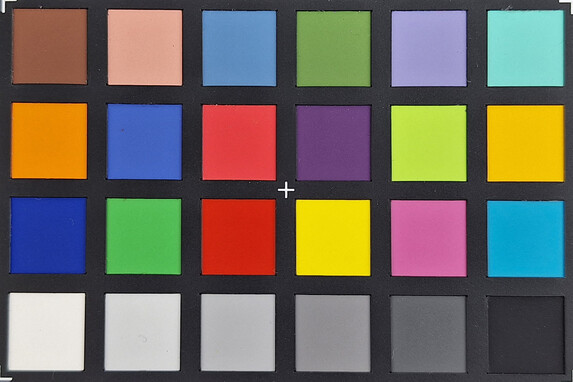
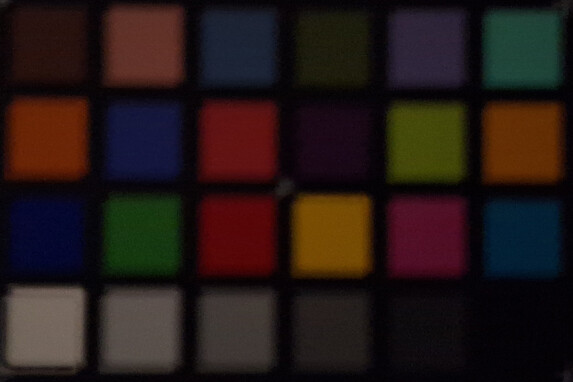
Features and guarantee - Much of it is optional
The Samsung Galaxy A54 5G possesses a 24-month manufacturer's guarantee and can be extended to include the Care+ insurance package. This can be booked for one or two years and, additionally, it can also include theft insurance. Depending on the chosen package, the price sits between $49 and $149. Up to two damage claims can be made per year for which an additional service fee of $49 or $99 (theft) is charged. Anyone choosing the A54 Enterprise Edition receives, amongst other things, one year's additional guarantee.
Out-of-the-box, the device only comes with a USB cable as well as a small tool for opening the card slot. Optional accessories are available from Samsung and other third-party suppliers.
Input devices & operation - Complete with an in-display optical fingerprint sensor
Samsung does not put a screen protector on the display direct from the factory. The Corning Gorilla Glass 5 is smooth to the touch and the Galaxy A54's capacitive touchscreen responds precisely to inputs.
An in-display optical fingerprint sensor is responsible for biometric security and although it recognizes the user's saved digits reliably, we would have preferred it to be a little faster. Optionally or additionally, the front-facing camera can be used for face recognition. However, this is faster but somewhat less secure.
Once again, the function or power button has been pre-assigned to Samsung's Bixby assistant. This can be switched off and returned to the classic option in the settings. On top of that, the button can be customized so that a double button press opens the camera or any other designated app.
The Galaxy A54's vibration motor works very quietly and with delicate haptic feedback, something we very much appreciated. The vibration strength can also be customised in the settings.
Display - An extremely bright 120 Hz Super AMOLED
The Samsung Galaxy A54 5G possesses a 6.4-inch, FullHD+, Super AMOLED panel, running at up to 120 Hz. The dynamic adaptive refresh rate is limited to automatic switching between 60 and 120 Hz. Alternatively, this can be set to a fixed 60 Hz. The smartphone supports the HDR standards HLG, HDR10+ as well as HDR10. Likewise, an always-on-display can also be configured.
The brightness has improved considerably compared to last year's Galaxy A53. With a pure white display and the ambient light sensor activated, the A54's panel achieved an average of 935 cd/m² and is illuminated very evenly. With an even split of light and dark areas (APL18), we were able to measure a peak brightness of 1390 cd/m². Set to manual, up to 433 cd/m² is possible.
At minimum display brightness, an irregular display flickering between 120 and 253 Hz is present and is something which could cause eye strain. However, if the brightness is increased only minimally, the panel switches to a very consistent periodic curve of 240 Hz which should be significantly easier on the eyes. The PWM comparison (see photo) with the Magic5 Pro shows that at the lowest brightness settings, the Galaxy A54 doesn't implement any significant DC dimming techniques in order to protect the user's eyes.
| |||||||||||||||||||||||||
Brightness Distribution: 99 %
Center on Battery: 940 cd/m²
Contrast: ∞:1 (Black: 0 cd/m²)
ΔE ColorChecker Calman: 2.4 | ∀{0.5-29.43 Ø4.78}
ΔE Greyscale Calman: 2.2 | ∀{0.09-98 Ø5}
99.6% sRGB (Calman 2D)
Gamma: 2.05
CCT: 6422 K
| Samsung Galaxy A54 5G Super AMOLED, 2340x1080, 6.4" | Xiaomi 13 Lite AMOLED, 2400x1080, 6.6" | Apple iPhone SE 2022 IPS, 1334x750, 4.7" | Google Pixel 6a AMOLED, 2400x1080, 6.1" | Sony Xperia 10 IV OLED, 2520x1080, 6" | Samsung Galaxy A53 AMOLED, 2400x1080, 6.5" | |
|---|---|---|---|---|---|---|
| Screen | 10% | -9% | 11% | 13% | -7% | |
| Brightness middle (cd/m²) | 940 | 905 -4% | 662 -30% | 758 -19% | 572 -39% | 718 -24% |
| Brightness (cd/m²) | 935 | 904 -3% | 647 -31% | 767 -18% | 580 -38% | 730 -22% |
| Brightness Distribution (%) | 99 | 99 0% | 92 -7% | 93 -6% | 96 -3% | 92 -7% |
| Black Level * (cd/m²) | 0.4 | |||||
| Colorchecker dE 2000 * | 2.4 | 1 58% | 1.44 40% | 0.9 62% | 0.9 62% | 1.62 32% |
| Colorchecker dE 2000 max. * | 3.2 | 3 6% | 4.74 -48% | 2.5 22% | 1.2 62% | 4.21 -32% |
| Greyscale dE 2000 * | 2.2 | 2.2 -0% | 1.7 23% | 1.6 27% | 1.4 36% | 2 9% |
| Gamma | 2.05 107% | 2.23 99% | 2.179 101% | 2.2 100% | 2.29 96% | 2.156 102% |
| CCT | 6422 101% | 6382 102% | 6746 96% | 6599 98% | 6614 98% | 6545 99% |
| Contrast (:1) | 1655 |
* ... smaller is better
Screen Flickering / PWM (Pulse-Width Modulation)
| Screen flickering / PWM detected | 253 Hz | ||
The display backlight flickers at 253 Hz (worst case, e.g., utilizing PWM) . The frequency of 253 Hz is relatively high, so most users sensitive to PWM should not notice any flickering. However, there are reports that some users are still sensitive to PWM at 500 Hz and above, so be aware. In comparison: 53 % of all tested devices do not use PWM to dim the display. If PWM was detected, an average of 8111 (minimum: 5 - maximum: 343500) Hz was measured. | |||
Series of measurements with a fixed level of zoom and various brightness settings
The Galaxy A54's panel achieves its most natural color reproduction when Natural display mode is selected. However, the panel then selects the smaller sRGB color space. In the Vivid mode preset, the image appears cooler and colors seem slightly less saturated, albeit using the larger DCI P3 color space.
The Pixel 6a and the Xperia 10 IV manage to display gray scales and colors more accurately, although we doubt whether this is visible to the naked eye.
Display Response Times
| ↔ Response Time Black to White | ||
|---|---|---|
| 1.67 ms ... rise ↗ and fall ↘ combined | ↗ 0.874 ms rise | |
| ↘ 0.791 ms fall | ||
| The screen shows very fast response rates in our tests and should be very well suited for fast-paced gaming. In comparison, all tested devices range from 0.1 (minimum) to 240 (maximum) ms. » 9 % of all devices are better. This means that the measured response time is better than the average of all tested devices (20.2 ms). | ||
| ↔ Response Time 50% Grey to 80% Grey | ||
| 1.55 ms ... rise ↗ and fall ↘ combined | ↗ 0.775 ms rise | |
| ↘ 0.7755 ms fall | ||
| The screen shows very fast response rates in our tests and should be very well suited for fast-paced gaming. In comparison, all tested devices range from 0.165 (minimum) to 636 (maximum) ms. » 6 % of all devices are better. This means that the measured response time is better than the average of all tested devices (31.6 ms). | ||
Outdoors, the Samsung Galaxy A54 5G is impressive and remains easily legible due to its high brightness, even on sunny days. At most, reflections can be considered a little annoying.
In this category, the Xiaomi 13 Lite and the Motorola Edge 30 Fusion get similarly bright.
Performance - Only minimal benefits due to the new Exynos 1380
The Galaxy A54 5G has gone for its in-house Samsung Exynos 1380 chipset with 8 GB of LPDDR4x RAM. The SoC is very similar to its predecessor, the Exynos 1280 which, for example, can be found in the Galaxy A53. However, Samsung has reorganised the two clusters: Two energy-saving cores have been removed and have, instead, been replaced by two additional Cortex-A78 cores, promising a boost in performance.
In Geekbench 5.4, the CPU's single-core performance sits at a similar level due to an almost identical clock speed but there is a whopping 50 percent boost in multi-core performance. Notably, the Exynos 1380 can also outperform the Snapdragon 7 Gen 1 found in the Xiaomi 13 Lite. However, the A54 has no chance compared to the Pixel 6a's Tensor.
That is also similar in the area of system benchmarks with the Samsung smartphone only managing to rise to the top of the pack in PCMark. In everyday use, the Galaxy A54 impresses due to its generally smooth performance although that is not without the appearance of an occasional stutter.
| UL Procyon AI Inference for Android - Overall Score NNAPI | |
| Xiaomi 13 Lite | |
| Google Pixel 6a | |
| Average of class Smartphone (3769 - 81594, n=138, last 2 years) | |
| Sony Xperia 10 IV | |
| Average Samsung Exynos 1380 (5835 - 6320, n=7) | |
| Samsung Galaxy A54 5G | |
| Samsung Galaxy A53 | |
| AImark - Score v3.x | |
| Xiaomi 13 Lite | |
| Average of class Smartphone (82 - 307528, n=125, last 2 years) | |
| Samsung Galaxy A54 5G | |
| Average Samsung Exynos 1380 (545 - 647, n=7) | |
Samsung has also fine-tuned the graphics chip and even given the Exynos 1280's Mali-G68 MP4 an additional core. In accordance with mathematical rules (and something which the benchmarks confirm), the ARM Mali-G68 MP5 enjoys a performance boost of between 25 and 30 percent over its predecessor. Although, this is not enough to top the Adreno 644 found in the Xiaomi 13 Lite. That chip is an additional 23 percent faster.
GFXBench (DX / GLBenchmark) 2.7: T-Rex Onscreen | 1920x1080 T-Rex Offscreen
GFXBench 3.0: on screen Manhattan Onscreen OGL | 1920x1080 1080p Manhattan Offscreen
GFXBench 3.1: on screen Manhattan ES 3.1 Onscreen | 1920x1080 Manhattan ES 3.1 Offscreen
GFXBench: on screen Car Chase Onscreen | 1920x1080 Car Chase Offscreen | on screen Aztec Ruins High Tier Onscreen | 2560x1440 Aztec Ruins High Tier Offscreen | on screen Aztec Ruins Normal Tier Onscreen | 1920x1080 Aztec Ruins Normal Tier Offscreen | 3840x2160 4K Aztec Ruins High Tier Offscreen
| 3DMark / Wild Life Extreme Unlimited | |
| Apple iPhone SE 2022 | |
| Google Pixel 6a | |
| Xiaomi 13 Lite | |
| Samsung Galaxy A54 5G | |
| Samsung Galaxy A53 | |
| Sony Xperia 10 IV | |
| 3DMark / Wild Life Extreme | |
| Apple iPhone SE 2022 | |
| Google Pixel 6a | |
| Xiaomi 13 Lite | |
| Samsung Galaxy A54 5G | |
| Samsung Galaxy A53 | |
| Sony Xperia 10 IV | |
| 3DMark / Wild Life Unlimited Score | |
| Apple iPhone SE 2022 | |
| Google Pixel 6a | |
| Xiaomi 13 Lite | |
| Samsung Galaxy A54 5G | |
| Samsung Galaxy A53 | |
| Sony Xperia 10 IV | |
| 3DMark / Wild Life Score | |
| Apple iPhone SE 2022 | |
| Google Pixel 6a | |
| Xiaomi 13 Lite | |
| Samsung Galaxy A54 5G | |
| Samsung Galaxy A53 | |
| Sony Xperia 10 IV | |
| 3DMark / Sling Shot Extreme (ES 3.1) Unlimited Physics | |
| Google Pixel 6a | |
| Samsung Galaxy A54 5G | |
| Sony Xperia 10 IV | |
| Xiaomi 13 Lite | |
| Samsung Galaxy A53 | |
| 3DMark / Sling Shot Extreme (ES 3.1) Unlimited Graphics | |
| Google Pixel 6a | |
| Xiaomi 13 Lite | |
| Samsung Galaxy A54 5G | |
| Samsung Galaxy A53 | |
| Sony Xperia 10 IV | |
| 3DMark / Sling Shot Extreme (ES 3.1) Unlimited | |
| Google Pixel 6a | |
| Xiaomi 13 Lite | |
| Samsung Galaxy A54 5G | |
| Samsung Galaxy A53 | |
| Sony Xperia 10 IV | |
| GFXBench (DX / GLBenchmark) 2.7 / T-Rex Onscreen | |
| Xiaomi 13 Lite | |
| Samsung Galaxy A54 5G | |
| Samsung Galaxy A53 | |
| Apple iPhone SE 2022 | |
| Sony Xperia 10 IV | |
| Google Pixel 6a | |
| GFXBench (DX / GLBenchmark) 2.7 / T-Rex Offscreen | |
| Apple iPhone SE 2022 | |
| Google Pixel 6a | |
| Xiaomi 13 Lite | |
| Samsung Galaxy A54 5G | |
| Sony Xperia 10 IV | |
| Samsung Galaxy A53 | |
| GFXBench 3.0 / Manhattan Onscreen OGL | |
| Xiaomi 13 Lite | |
| Samsung Galaxy A54 5G | |
| Apple iPhone SE 2022 | |
| Google Pixel 6a | |
| Samsung Galaxy A53 | |
| Sony Xperia 10 IV | |
| GFXBench 3.0 / 1080p Manhattan Offscreen | |
| Apple iPhone SE 2022 | |
| Google Pixel 6a | |
| Xiaomi 13 Lite | |
| Samsung Galaxy A54 5G | |
| Samsung Galaxy A53 | |
| Sony Xperia 10 IV | |
| GFXBench 3.1 / Manhattan ES 3.1 Onscreen | |
| Apple iPhone SE 2022 | |
| Google Pixel 6a | |
| Xiaomi 13 Lite | |
| Samsung Galaxy A54 5G | |
| Samsung Galaxy A53 | |
| Sony Xperia 10 IV | |
| GFXBench 3.1 / Manhattan ES 3.1 Offscreen | |
| Google Pixel 6a | |
| Xiaomi 13 Lite | |
| Apple iPhone SE 2022 | |
| Samsung Galaxy A54 5G | |
| Samsung Galaxy A53 | |
| Sony Xperia 10 IV | |
| GFXBench / Car Chase Onscreen | |
| Apple iPhone SE 2022 | |
| Google Pixel 6a | |
| Xiaomi 13 Lite | |
| Samsung Galaxy A54 5G | |
| Samsung Galaxy A53 | |
| Sony Xperia 10 IV | |
| GFXBench / Car Chase Offscreen | |
| Apple iPhone SE 2022 | |
| Google Pixel 6a | |
| Xiaomi 13 Lite | |
| Samsung Galaxy A54 5G | |
| Samsung Galaxy A53 | |
| Sony Xperia 10 IV | |
| GFXBench / Aztec Ruins High Tier Onscreen | |
| Apple iPhone SE 2022 | |
| Google Pixel 6a | |
| Xiaomi 13 Lite | |
| Samsung Galaxy A54 5G | |
| Samsung Galaxy A53 | |
| Sony Xperia 10 IV | |
| GFXBench / Aztec Ruins High Tier Offscreen | |
| Apple iPhone SE 2022 | |
| Google Pixel 6a | |
| Xiaomi 13 Lite | |
| Samsung Galaxy A54 5G | |
| Samsung Galaxy A53 | |
| Sony Xperia 10 IV | |
| GFXBench / Aztec Ruins Normal Tier Onscreen | |
| Apple iPhone SE 2022 | |
| Google Pixel 6a | |
| Xiaomi 13 Lite | |
| Samsung Galaxy A54 5G | |
| Samsung Galaxy A53 | |
| Sony Xperia 10 IV | |
| GFXBench / Aztec Ruins Normal Tier Offscreen | |
| Apple iPhone SE 2022 | |
| Google Pixel 6a | |
| Xiaomi 13 Lite | |
| Samsung Galaxy A54 5G | |
| Samsung Galaxy A53 | |
| Sony Xperia 10 IV | |
| GFXBench / 4K Aztec Ruins High Tier Offscreen | |
| Google Pixel 6a | |
| Xiaomi 13 Lite | |
| Samsung Galaxy A54 5G | |
| Sony Xperia 10 IV | |
Basemark GPU score
When surfing the internet, The Galaxy A54 is extremely speedy and manages to outpace the slightly faster Pixel 6a in WebXPRT 4, Mozilla Kraken and Octane 2.0. Surfing speed is equally as impressive in everyday use.
| Jetstream 2 - 2.0 Total Score | |
| Apple iPhone SE 2022 (Chrome 99) | |
| Average of class Smartphone (23.8 - 387, n=152, last 2 years) | |
| Average Samsung Exynos 1380 (94.6 - 121.8, n=6) | |
| Samsung Galaxy A54 5G (Chrome 112) | |
| Google Pixel 6a (Firefox 1ß4-2-ß) | |
| Xiaomi 13 Lite (Chrome 111.0.5563.115) | |
| Samsung Galaxy A53 (Chrome 101) | |
| Sony Xperia 10 IV (Chrome 103.0.5060.129) | |
| Speedometer 2.0 - Result 2.0 | |
| Apple iPhone SE 2022 (Chome 99) | |
| Average of class Smartphone (15.2 - 643, n=126, last 2 years) | |
| Average Samsung Exynos 1380 (70.5 - 127, n=5) | |
| Google Pixel 6a (Chrome 105.0.5195.79) | |
| Samsung Galaxy A54 5G (Chrome 112) | |
| Xiaomi 13 Lite (Chrome 111.0.5563.115) | |
| Samsung Galaxy A53 (Chome 101) | |
| Sony Xperia 10 IV (Chrome 103.0.5060.129) | |
| WebXPRT 4 - Overall | |
| Average of class Smartphone (27 - 306, n=148, last 2 years) | |
| Average Samsung Exynos 1380 (97 - 123, n=7) | |
| Samsung Galaxy A54 5G (Chrome 112) | |
| Xiaomi 13 Lite (Chrome 111.0.5563.115) | |
| Google Pixel 6a (Chrome 105.0.5195.79) | |
| Sony Xperia 10 IV (Chrome 103.0.5060.129) | |
| Octane V2 - Total Score | |
| Apple iPhone SE 2022 (Chrome 99) | |
| Average of class Smartphone (2228 - 121337, n=200, last 2 years) | |
| Average Samsung Exynos 1380 (33801 - 39283, n=7) | |
| Samsung Galaxy A54 5G (Chrome 112) | |
| Google Pixel 6a (Chrome 105.0.5195.79) | |
| Xiaomi 13 Lite (Chrome 111.0.5563.115) | |
| Samsung Galaxy A53 (Chrome 101) | |
| Sony Xperia 10 IV (Chrome 103.0.5060.129) | |
| Mozilla Kraken 1.1 - Total | |
| Sony Xperia 10 IV (Chrome 103.0.5060.129) | |
| Samsung Galaxy A53 (Chrome 101) | |
| Google Pixel 6a (Chrome 105.0.5195.79) | |
| Xiaomi 13 Lite (Chrome 111.0.5563.115) | |
| Samsung Galaxy A54 5G (Chrome 112) | |
| Average of class Smartphone (257 - 28190, n=155, last 2 years) | |
| Average Samsung Exynos 1380 (975 - 1209, n=7) | |
| Apple iPhone SE 2022 (Chrome 99) | |
* ... smaller is better
In our Galaxy A53 review, the slow storage was already a point of criticism. Unfortunately, that's the same with the Galaxy A54 which has opted for the marginally quicker UFS 2.2 storage. The one found in the Xiaomi 13 Lite is even up to 160 percent faster. In particular, small data block write speeds are very slow.
| Samsung Galaxy A54 5G | Xiaomi 13 Lite | Google Pixel 6a | Sony Xperia 10 IV | Samsung Galaxy A53 | Average 128 GB UFS 2.2 Flash | Average of class Smartphone | |
|---|---|---|---|---|---|---|---|
| AndroBench 3-5 | 149% | 119% | 45% | 60% | 61% | 292% | |
| Sequential Read 256KB (MB/s) | 528.32 | 1001.82 90% | 1312.64 148% | 521.1 -1% | 510.1 -3% | 736 ? 39% | 2222 ? 321% |
| Sequential Write 256KB (MB/s) | 335.39 | 871.96 160% | 712.94 113% | 497.61 48% | 486.7 45% | 532 ? 59% | 1841 ? 449% |
| Random Read 4KB (MB/s) | 236.23 | 277.33 17% | 219.53 -7% | 192.5 -19% | 229.9 -3% | 193 ? -18% | 294 ? 24% |
| Random Write 4KB (MB/s) | 70.52 | 301.41 327% | 225.61 220% | 177.83 152% | 210.8 199% | 186.3 ? 164% | 334 ? 374% |
Gaming - The Galaxy smartphone comes with a limited fun factor
Thanks to its mid-range ARM Mali-G68 MP5 SoC, the Samsung Galaxy A54 5G has more than enough computing power for most games. As a selected number of games show in our tests, it is also sufficient for graphically demanding games but sometimes with reduced details and frame rates if these are not already limited by the smartphone.
At best, the shooter PUBG can be run in HD settings and not higher than 30fps, even when details are reduced again. Diablo Immortal runs at higher frame rates but not at the highest detail settings. Our test settings ran at low graphical details and still displayed occasional dropped frames.
The Galaxy A54 almost reached its limits with Genshin Impact. Playing at medium and high detail settings isn't really fun and even at the lowest graphic settings the frame rate stuttered now and again. However, with Game Launcher and Booster, useful tools that we know from the Galaxy S23 are on board.
Outside of demanding games, the A54 is still enjoyable thanks mainly to the very good display and the decent dual speakers.
Emissions - Dual speakers for the Galaxy A54 5G
Temperature
When running idle, the Galaxy A54's surface temperatures remain pleasantly low but increase noticeably under load and can reach up to 37.6 °C. Considering the mid-range SoC, this is surprisingly high but at no point problematic.
Internally, heat is successfully dissipated as throttling was absent in both 3DMark Wild Life stress tests. This looks different with the potentially better-equipped Pixel 6a which remains noticeably faster under load despite a massive loss in performance.
(+) The maximum temperature on the upper side is 37.4 °C / 99 F, compared to the average of 35.2 °C / 95 F, ranging from 21.9 to 247 °C for the class Smartphone.
(+) The bottom heats up to a maximum of 37.6 °C / 100 F, compared to the average of 34 °C / 93 F
(+) In idle usage, the average temperature for the upper side is 26.9 °C / 80 F, compared to the device average of 32.9 °C / 91 F.
3DMark Wild Life Stress Test
| 3DMark | |
| Wild Life Stress Test Stability | |
| Samsung Galaxy A53 | |
| Sony Xperia 10 IV | |
| Xiaomi 13 Lite | |
| Samsung Galaxy A54 5G | |
| Apple iPhone SE 2022 | |
| Google Pixel 6a | |
| Wild Life Extreme Stress Test | |
| Xiaomi 13 Lite | |
| Samsung Galaxy A54 5G | |
| Sony Xperia 10 IV | |
| Samsung Galaxy A53 | |
| Apple iPhone SE 2022 | |
| Google Pixel 6a | |
Speakers
The Samsung Galaxy A54 has decent dual speakers at its disposal. However, they sound worse than any of the Galaxy S series. Precision is missing in both the highs and, in particular, the lows. Even at medium volume, they sound echoey and hollow.
Wired headphones or external speakers can be connected via the USB-C port. A wireless option is provided by Bluetooth 5.3 but only has the SBC, AAC, aptX, LDAC and SSC audio codecs. Anyone wishing to simultaneously provide two Bluetooth receivers with sound (dual-audio) will have to do so with SBC.
Samsung Galaxy A54 5G audio analysis
(+) | speakers can play relatively loud (88.7 dB)
Bass 100 - 315 Hz
(-) | nearly no bass - on average 23.2% lower than median
(±) | linearity of bass is average (11.3% delta to prev. frequency)
Mids 400 - 2000 Hz
(±) | reduced mids - on average 6.4% lower than median
(+) | mids are linear (5.5% delta to prev. frequency)
Highs 2 - 16 kHz
(±) | higher highs - on average 6% higher than median
(+) | highs are linear (2.8% delta to prev. frequency)
Overall 100 - 16.000 Hz
(±) | linearity of overall sound is average (17.8% difference to median)
Compared to same class
» 14% of all tested devices in this class were better, 9% similar, 77% worse
» The best had a delta of 11%, average was 35%, worst was 134%
Compared to all devices tested
» 35% of all tested devices were better, 8% similar, 57% worse
» The best had a delta of 4%, average was 24%, worst was 134%
Google Pixel 6a audio analysis
(+) | speakers can play relatively loud (87.4 dB)
Bass 100 - 315 Hz
(-) | nearly no bass - on average 21.5% lower than median
(±) | linearity of bass is average (9.6% delta to prev. frequency)
Mids 400 - 2000 Hz
(+) | balanced mids - only 4.2% away from median
(+) | mids are linear (4.4% delta to prev. frequency)
Highs 2 - 16 kHz
(+) | balanced highs - only 4.7% away from median
(+) | highs are linear (6.1% delta to prev. frequency)
Overall 100 - 16.000 Hz
(±) | linearity of overall sound is average (16.1% difference to median)
Compared to same class
» 5% of all tested devices in this class were better, 4% similar, 90% worse
» The best had a delta of 11%, average was 35%, worst was 134%
Compared to all devices tested
» 25% of all tested devices were better, 5% similar, 70% worse
» The best had a delta of 4%, average was 24%, worst was 134%
Battery life - 5,000 mAh with better runtimes
Power consumption
The Galaxy A54's power consumption can be described as economical but when idle it is slightly higher than that of the A53. Less surprisingly, the same applies under full load as well as in tests using adaptive display brightness.
The A54 supports fast charging up to 25 watts. We checked this using a suitable mains adapter from Samsung. A full battery charge requires almost one and a half hours. After 27 minutes, the power storage is half full. The 80 percent mark is reached after 49 minutes and 90 percent after 58 minutes. The A54 needed a lengthy 27 minutes for the last ten percent - not exactly fast. The Samsung smartphone does not support wireless charging.
| Off / Standby | |
| Idle | |
| Load |
|
Key:
min: | |
| Samsung Galaxy A54 5G 5000 mAh | Xiaomi 13 Lite 4500 mAh | Apple iPhone SE 2022 2018 mAh | Google Pixel 6a 4410 mAh | Sony Xperia 10 IV 5000 mAh | Samsung Galaxy A53 5000 mAh | Average Samsung Exynos 1380 | Average of class Smartphone | |
|---|---|---|---|---|---|---|---|---|
| Power Consumption | 9% | 2% | 0% | 17% | -1% | -68% | -16% | |
| Idle Minimum * (Watt) | 0.75 | 0.74 1% | 0.6 20% | 0.68 9% | 0.68 9% | 0.9 -20% | 1.259 ? -68% | 0.848 ? -13% |
| Idle Average * (Watt) | 1.51 | 1.56 -3% | 0.9 40% | 1.56 -3% | 1.69 -12% | 1.3 14% | 2.85 ? -89% | 1.434 ? 5% |
| Idle Maximum * (Watt) | 1.62 | 1.59 2% | 1.5 7% | 1.58 2% | 1.73 -7% | 1.6 1% | 3 ? -85% | 1.618 ? -0% |
| Load Average * (Watt) | 4.91 | 3.33 32% | 6.5 -32% | 5.37 -9% | 2.54 48% | 5.7 -16% | 7.85 ? -60% | 7.01 ? -43% |
| Load Maximum * (Watt) | 8.93 | 7.59 15% | 11 -23% | 8.74 2% | 4.61 48% | 7.3 18% | 12.5 ? -40% | 11.3 ? -27% |
* ... smaller is better
Power consumption: Geekbench (150 cd/m²)
Power consumption: GFXBench (150 cd/m²)
Battery life
Like its predecessor, the Galaxy A54 has a 5,000 mAh battery. Anyone expecting battery life similar to that of the Galaxy A53 will be pleasantly surprised as our tests highlighted better performance in every area. Significant improvements can be seen, especially when it comes to video playback.
The Galaxy A54 is also superior to most of its peers with only the Xperia 10 IV possessing more stamina when all the other's lights had already gone out.
| Samsung Galaxy A54 5G 5000 mAh | Xiaomi 13 Lite 4500 mAh | Apple iPhone SE 2022 2018 mAh | Google Pixel 6a 4410 mAh | Sony Xperia 10 IV 5000 mAh | Samsung Galaxy A53 5000 mAh | |
|---|---|---|---|---|---|---|
| Battery runtime | -8% | -32% | -8% | 32% | -12% | |
| Reader / Idle (h) | 43.2 | 37.3 -14% | 34.2 -21% | 31.3 -28% | 62.7 45% | 40.5 -6% |
| H.264 (h) | 25.1 | 19.8 -21% | 13.3 -47% | 22 -12% | 26.3 5% | 19.1 -24% |
| WiFi v1.3 (h) | 15.7 | 13.7 -13% | 12.8 -18% | 12.8 -18% | 19.5 24% | 14.8 -6% |
| Load (h) | 4.7 | 5.4 15% | 2.7 -43% | 6 28% | 7.2 53% | 4.1 -13% |
Pros
Cons
Verdict - Not everything is awesome in the Galaxy A54
Samsung advertizes its Galaxy A series with the slogan „A for Awesome“ and, in actual fact, the company behind the Galaxy A54 continues to succeed in developing the range. Once again, it is offering a really good smartphone this year.
The device includes tangible upgrades in terms of the display which is now brighter, has better battery life and a decent triple-camera system. The first eSIM support in its own mid-range is a feature we very much welcome. Other areas which speak in favour of the Galaxy A54 5G include very good quality location positioning, fast Wi-Fi 6 as well as long-term updates. In addition, the new design looks and feels considerably more premium.
The Samsung Galaxy A54 5G is a very good mid-range smartphone but our review also reveals a few weaknesses.
However, the Samsung smartphone must also put up with criticism: The processor's additional performance cores are faster, but, this isn't always enough, particularly when gaming. It is also noticeable when navigating the system and is something that can be attributed to slow memory. The slow charging speed may be easy on the battery but hard on your patience levels, especially if speed is top of your agenda.
In light of the very high starting RRP of $449, we would like to have seen at least one more premium feature. Whether it be a more powerful SoC, wireless charging or more modern display technology. Exciting alternatives in this price category come in the form of the Google Pixel 6a, the Motorola Edge 30 Fusion as well as the Xiaomi 13 Lite.
Price and availability
The Galaxy A54 5G is available in every color and storage variant and can currently be ordered directly from Samsung's online store for $449.
Samsung Galaxy A54 5G
- 01/30/2024 v7 (old)
Daniel Schmidt
Transparency
The selection of devices to be reviewed is made by our editorial team. The test sample was provided to the author as a loan by the manufacturer or retailer for the purpose of this review. The lender had no influence on this review, nor did the manufacturer receive a copy of this review before publication. There was no obligation to publish this review. As an independent media company, Notebookcheck is not subjected to the authority of manufacturers, retailers or publishers.
This is how Notebookcheck is testing
Every year, Notebookcheck independently reviews hundreds of laptops and smartphones using standardized procedures to ensure that all results are comparable. We have continuously developed our test methods for around 20 years and set industry standards in the process. In our test labs, high-quality measuring equipment is utilized by experienced technicians and editors. These tests involve a multi-stage validation process. Our complex rating system is based on hundreds of well-founded measurements and benchmarks, which maintains objectivity. Further information on our test methods can be found here.




